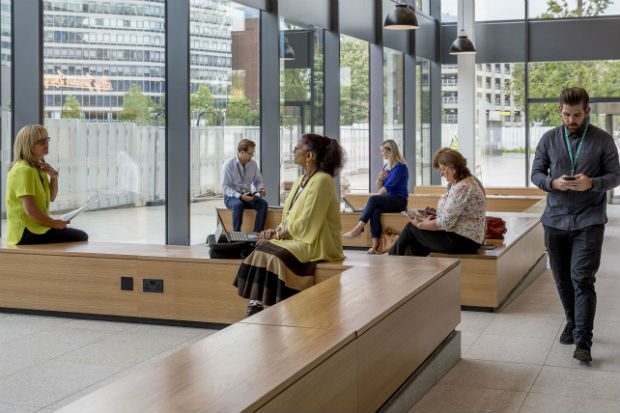The foyer of HMRC's Croydon Regional Centre
Every aspect of our lives is now firmly under the influence of technology. Whether you’re sitting at home watching Netflix, catching a bus, ordering food or checking up on football scores. And our places of work are no different.
Bringing new digital technology into where we work not only makes some of our routine processes or daily tasks easier, data and ‘smart’ buildings offer a greater insight into what needs to be built and what the needs are of those using our buildings. That’s why HMRC has signed an agreement with 15 companies to create some of the most digitally advanced buildings in government.
The signing of the Digital Charter means that all organisations involved in constructing and maintaining HMRC buildings will focus on maximising the use of data and implementing the latest digital technology.
This includes smart internet of things (IoT)-based technology, where systems interact with each other. A great example of where this will provide benefits for those using the building is heating. Costly and building-critical equipment such as boilers and chillers already often come equipped with sensors to collect data on how they are functioning.
We are looking to build on this by adding extra IoT sensors to collect data such as current draw, noise produced by bearings, vibration level, revolutions per minute. This will form a real-time picture of how the equipment is functioning on a live building performance dashboard, and enable building managers to identify anomalies, which they can send an engineer to investigate. This is called condition-based maintenance and will move us away from a planned maintenance regime to a situation where we monitor equipment performance more proactively and intervene before faults occur, reducing downtime.
The charter signing follows extensive development of the HMRC Estates Digital Blueprint strategy, which outlines how making use of the latest digital technology will help everyone who works in HMRC Regional Centres (for example, through streamlined app-based services). Through the use of the latest technology, projects will be made more efficient and data will be employed to make architectural and design decisions as HMRC continues with its estates transformation programme, catering for our needs now and in the future.
Digital technology gives us the opportunity to move to modern, collaborative and highly efficient buildings, and will provide us and our supply chain with the data and insights we need so we can offer an excellent experience to people who work in and visit our buildings.
We are always looking to deliver the best buildings in government and, quite simply, a digital-first approach is the key to achieving this ambition.
If you would like to know more about how HMRC is incorporating digital technology into its regional centres, you can email: digitalblueprint.estates@hmrc.gov.uk.



